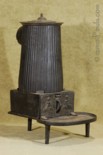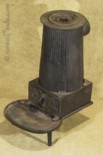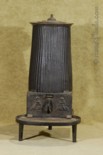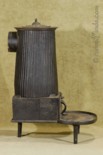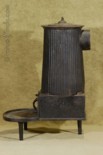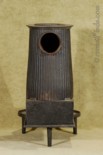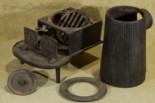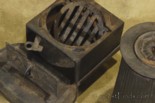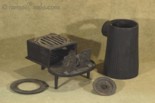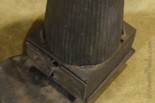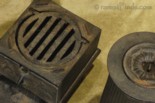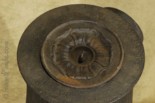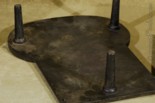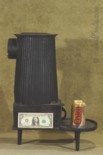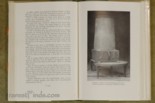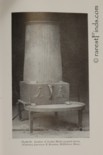Very early, and exceedingly rare, cast iron Stove, patented by Jordan L. Mott in 1835, probably only the second one extant! Price, $1,750.
Patent, click on any image to see larger image!
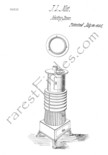
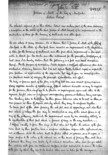
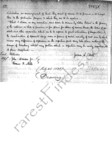
Jordan Lawrence Mott was an American Inventor and Industrialist. He was born on October 12th, 1799. His father was Jacob Mott, an alderman of New York in 1804-1810 and at one time acting mayor of the city, after whom Mott Street was named. Jacob's wife was related to James Lawrence, a naval officer in the War of 1812. The family are said to be descended from Adam Mott from Essex, England, who arrived in the United States before 1647.
Jordan L. Mott was listed as grocer in city directories until 1834, and thereafter as stove-maker. He opened his own workshop and store on Water Street, the heart of New York City's stove district. He eventually established the J.L. Mott Iron Works in New York City, and became one of the largest manufacturer of cast iron stoves and other cast iron products. He died at age 66 on May 8th, 1866, in New York City.
The reader can find endless information about Jordan L. Mott on the internet; I will try to point out information not to be found on the internet.
The Patent:
There is little know about the patent this stove is based on. The patent was issued on July 21, 1835. Back in 1835, patents were written by hand by the inventor and submitted to the Patent Office. Just 17 months after Mott filed his handwritten patent, on December 15th, 1836, all patents were destroyed by a fire which started at 3am.
Before that tragic cold day in December of 1836, 9,957 patents had been issued. Patents did not have numbers; numbers were only assigned to the lost patents once they were recovered from inventors, libraries, or universities which had copies by coincidence. Every patent so numbered has the prefix letter X. The effort to recover lost patents which were lost in the fire of 1836 is an ongoing effort to this day.
The patent issued on July 21, 1835, and shown above is one of these patents.
The handwriting is difficult to read and the patent not well known (because of it?); these might be the reasons why I could not find any information about the patent. Even so his invention sounds inconsequential and trivial, at the time it was the latest high-tech. Jordan Mott patented his idea of forming a stove body out of separate rings stacked on top of each other, or to rib or flute the surface in order to increase the surface. This would prevent the casting from cracking and increase at the same time heat radiation. He also protected his idea of interlocking parts "by rims or ledges, and corresponding grooves, or hollows, being cast upon their touching sides to keep them in their places [...]."
As I learned doing research, there were only very few made of this stove. Other than the picture in the book,
“Fire on the Hearth, The Evolution and Romance of the Heating-Stove, by Josephine H Peirce,” of another one like this one, I have not found any other images of tis stove.
Mott was manufacturing his stoves in different sizes; the one offered for sale here has the legs cast as part of the base-plate and not cast as separate pieces as the one shown in the book, “Fire on the Hearth,” I would see this as an indication that the stove shown in plate 85 is larger in size; I also can't imagine that Mott would offer a stove even smaller than 20 inches in height.
The only way I was able to identify this stove was with help of the book, “Fire on the Hearth.” The same stove as offered here for sale is shown on page 135, plate 85. Mott's patent pictured above also claims his invention with using cast rings to form the body of the stove. Such a stove is shown on page 133, plate 84. Josephine Peirce claims that Mott's Pyramid stoves were based on a patent issued in 1836. The patent with the number 50 issued on October 11, 1836. This is incorrect. As the reader can see, I found the right patent, the patent with the number X8983, which bears the date July 21, 1835.
The picture of the stove shown in Plate 85 was "Courtesy Lawrence B. Romaine, Middleboro, Mass." Lawrence B. Romaine (1900-1967) was an antiquarian book dealer, who bought and sold rare books, manuscripts, trade catalogs, and other Americana. Romaine was recognized as the leading expert in the U.S. on trade catalogs, and was the author of A Guide to American Trade Catalogs, 1774-1900 (New York: R. R. Bowker Company, 1960), the standard reference work in this field. To read about his collection, click here!
This early stove has not a so called "sunken ash-pit" as usually found in stoves burning the cheap wonder fuel, the Pennsylvania Anthracite which became available about 1820. The grate is tilt-able; the lever to release the grate sticks out in front of the stove through the front cover.
The letter "X" indicates that it was one of the patents distroyed by fire. X-Patents are all the patents issued by the United States Patent and Trademark Office from July 1790 (when the first U.S. patent was issued), to July 1836. The actual number is unknown, but the best estimate is 9,957. The records were burned in a fire, in December 1836, while in temporary storage. No copies or rosters were maintained by the government at the time, leaving only the inventors' copies to reconstruct the collection. The number 8983 was only assigned to this patent after the fire; as mentioned before, patents had no numbers untill about five months before the fire. The handwritten patent is difficult to read. However, I took the time to decipher the writing and would like to share it with the reader:
July 21, 1835 8983X
Jordon L. Mott, of the City of New York
Letters Patent
Jordon L. Mott, of the City of New York
Letters Patent
The schedule referred to in these Letters Patent and making part of the same, containing a description in the words of the said Jordan L. Mott himself of his improvement in the construction of Stoves for the burning of Anthracite and other fuel.
____________________________________
To all whom it may concern:
Be it known that I, Jordan L. Mott of the city of New York in the state of New York have invented an improvment in the construction of stoves, for the burning of anthracite and other fuel which improvment is also applicaple to retorts for gas works, and other instruments for the gnerarting or applying of heat, and I do hereby declare that the following is a full and exact description thereof. For the purpose of description I will suppose a vertical cylindrical stove to be constructed, observing however that I do not intend thereby to limit myself as respects the form, position, or application of the apparatus, but only to give an exemplification of a practical mode of carrying the principle of construction into effect.
The body or furnace part of this stove is to be of cast iron, and consists of any required number of separate rings, of such internal diameter as may be required for the furnice. These rings are to be placed or superimposed, upon each other to the required height, rims or ledges, and corresponding grooves, or hollows, being cast upon their touching sides to keep them in their places, holes are also to be cast in them, or ears formed on them to receive rods by which they may be confined together.
The lower part of the stove forming the ash pit, and its appendages, and also that part which is above the fire may be constructed in any of the usual forms, or of any of the ordinary materials the improvement made by me, consisting entirely in the construction of that part which is formed of rings, in the way described.
I intend usually to form these rings so that when put together the interior of the furnice shall by their junction have a uniform continious surface, either cylindrical, conical, or otherwise, whilst the outside shall be fluted, ribbed, or grooved, so as to expose a larger surface to the motion of the external air, as this mode of forming them, will tend to prevent them being over heated, by its intended radiation, when used for gas retorts, their outisides will form one continious surface, as best calculated to receive the action of the fire, by which they are to be heated, when used in tubes for the conveyance distribution or managment of heat, they must of course be so formed, as to adapt them to the particular purpose to which they are to be applied.
What I claim as my invention, and to secure by letters Patent is the forming of the exterior, or shell of furnaces or fire places, for stoves of various kinds, the bodies of gas retorts, and other apparatus which are to be exposed to great alterations of temperature, by the combination of separte rings rims or frames of metal usually of cast iron, by which means any difference of expansion in the respective parts may take place without the danger of breaking, whilst any portion which is defective may be easily removed, and its place supplied.
Jordan L. Mott
Witnesses
John Dewson
Thomas H. Mills
(July 21, 1835)
Condition:
Considering the fragile nature of cast iron and the fact that the pieces are just being held together by gravity, it is amazing that this stove is still extant and not destroyed by some event or accident during the last 185 plus years!
I could not find any cracks, his invention (with the ribbed surface) seem to have worked. I could also not find any repairs. This stove also seems to be complete; it is possible that part of the small handle to lift the round cover to refuel the stove, has a pice broken off. This small handle may had a loop; it is hard to tell as there are no other images out there which would allow me to make this determination. This stove is so increadibly rare...
History:
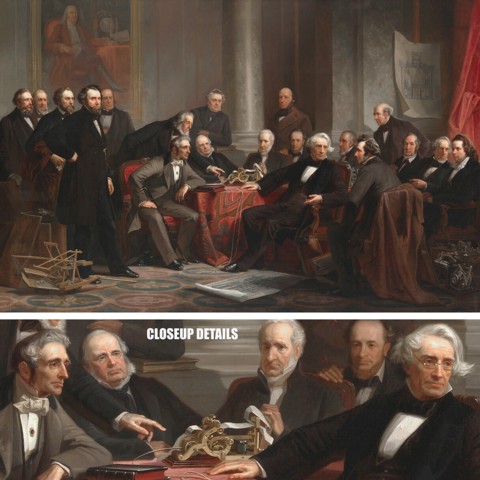 Nine years before his death, in 1857, Jordan Mott commissioned Christian Schussele to paint a 6 ft by 4 ft work entitled Men of Progress, representing himself and 18 other contemporary American inventors, click on image to download larger image! They never gathered together to pose, but sat for the artist individually.
Nine years before his death, in 1857, Jordan Mott commissioned Christian Schussele to paint a 6 ft by 4 ft work entitled Men of Progress, representing himself and 18 other contemporary American inventors, click on image to download larger image! They never gathered together to pose, but sat for the artist individually.
This group portrait is probably the best known of the ninetheenth century. By comparising the portrait above with the men in the picture, can you figure out which gentlemen is actually Jordan Mott?
Just before the finished picture was delivered in 1862, John Ericsson's Union ironclad vessel, the Monitor, had won its victory over the Confederacy's Merrimac. To mark the occasion, Ericsson's likeness was hastily added. In part because of these men and their inventions, the Civil War was America's first modern war. The picture is now owned by the Cooper Union, with a copy by John Sartain in the American National Portrait Gallery. Jordan Mott is the eighth person from the left, seated at the table.
Read also:
Howell Harris, a professor of History from the University of Durham, United Kingdom, did extensive studies and writings about the Cast-Iron Stove Industry in Victorian America. I used some of his information to write this page. He published his studies on his website. It is the best and most thoroug writing on the subject known to me, to access his increadible well researched and well documented studies, click here!Howell Harris wrote a post on his blog about the stoves manufactured by Jordan Mott, to read this post, click here!
Howell Harris also compiled a list of booklets and catalogues he found on the internet, to see the list, click here!
Inventory Number 09333;
Price: $ 1750.00.
